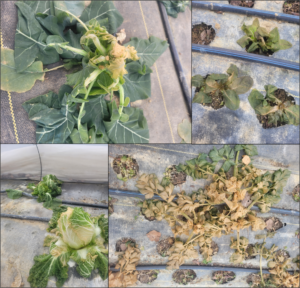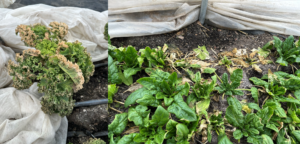A common approach in winter production is to allow crops to reach maturity or harvestable size by the end of November. High tunnels are then used as a ‘living refrigerator’ from December to around the middle of February. Crops are harvested as needed in the darkest and coldest periods. This approach, however, did not work well at some Indiana farms this winter because unexpectedly low temperatures occurred around Christmas. Temperatures reached -20°F (without wind chill) at farms across Indiana. Even though tunnels provided some protection, temperatures as low as -15°F were recorded inside the structures. With such extreme temperatures, many winter crops scheduled to be harvested and sold in January and February were lost in December. As such, some farms were forced to be out of the winter market for several weeks. After the frost killed or damaged the crops (Figures 1 and 2), we tend to replant immediately, hoping to recover from the loss as soon as possible. However, this approach proved to have little effect. One farmer showed me that lettuce transplanted at the end of December had almost no growth in the past two months, while the ones transplanted a few days ago looked healthier and were likely to outgrow the ones transplanted at the end of December. At another farm, spinach transplanted in December did not survive. These stories reiterated the importance of the combined effects of light and temperatures on winter growth. Even though we suffered losses from frost in December, it may not be a good idea to plant in the deep winter. Refer to Scheduling Fall and Winter Vegetable Production for more information about fall and winter planting. The recent warm temperatures and increased day length in February are very welcome. Many farms are busy planting. Those leafy vegetables will soon fill the spring market.

Figure 1. Temperatures inside the caterpillar tunnel in southern Indiana dropped to -15 °F on Dec. 23, 2022, killing various crops (a farmer provided the photo).

Figure 2. Kale and spinach grown in a high tunnel were damaged by the low temperatures on Dec. 22, 2023, in central Indiana.
This work is supported by a USDA/NIFA Specialty Crop Research Initiative (SCRI) [grant no. 2021-51181-35858/project accession no. 1027430].